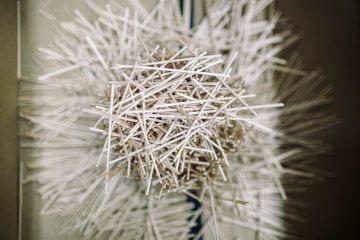Siobhan Roberts in The New York Times:
 The term “bird’s nest” has come to describe a messy hairdo, tangled fishing line and other unspeakably knotty conundrums. But that does birds an injustice. Their tiny brains, dense with neurons, produce marvels that have long captured scientific interest as naturally selected engineering solutions — yet nests are still not well understood. One effort to disentangle the structural dynamics of the nest is underway in the sunny yellow lab — the Mechanical Biomimetics and Open Design Lab — of Hunter King, an experimental soft-matter physicist at the University of Akron in Ohio. “We hypothesize that a bird nest might effectively be a disordered stick bomb, with just enough stored energy to keep it rigid,” Dr. King said. He is the principal investigator of an ongoing study, with a preliminary review paper, “Mechanics of randomly packed filaments — The ‘bird nest’ as meta-material,” recently published in the Journal of Applied Physics. (He added that, obviously, the bird-nest stick bomb never explodes.) Dr. King and his colleagues seek to answer simple questions: What is the underlying mechanical principle behind the bird nest’s construction strategy? What are the statistically robust characteristics of “the nest state”? That is to say, what separates a nest from the same sticks and twigs collected into a tight bundle or scattered helter-skelter?
The term “bird’s nest” has come to describe a messy hairdo, tangled fishing line and other unspeakably knotty conundrums. But that does birds an injustice. Their tiny brains, dense with neurons, produce marvels that have long captured scientific interest as naturally selected engineering solutions — yet nests are still not well understood. One effort to disentangle the structural dynamics of the nest is underway in the sunny yellow lab — the Mechanical Biomimetics and Open Design Lab — of Hunter King, an experimental soft-matter physicist at the University of Akron in Ohio. “We hypothesize that a bird nest might effectively be a disordered stick bomb, with just enough stored energy to keep it rigid,” Dr. King said. He is the principal investigator of an ongoing study, with a preliminary review paper, “Mechanics of randomly packed filaments — The ‘bird nest’ as meta-material,” recently published in the Journal of Applied Physics. (He added that, obviously, the bird-nest stick bomb never explodes.) Dr. King and his colleagues seek to answer simple questions: What is the underlying mechanical principle behind the bird nest’s construction strategy? What are the statistically robust characteristics of “the nest state”? That is to say, what separates a nest from the same sticks and twigs collected into a tight bundle or scattered helter-skelter?
“Birds perform what I’ve been calling ‘mechanical synthesis,’” Dr. King said. “Whereas, on a molecular scale, a chemist will synthesize polymers of varying length or stiffness in anticipation of bulk mechanical properties, the bird chooses skinny elements from its environment, with some selection criteria in expectation of nest performance.” A nest has a certain chemistry — an alchemy, almost. From humble parts, a greater sum emerges and coheres. And, presumably, its generic principle would not be exclusive to nests. Rather, it would be widely applicable to structures in architecture, packaging, shock-absorption and more.
More here.
